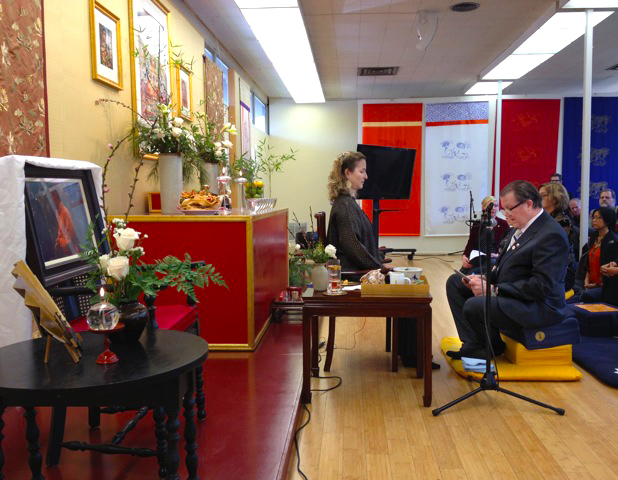Oaths in Shambhala
On Shambhala Day, Marian English and Tom Gottlieb took oaths of commitment to their new offices. Marian becomes our new head of practice while Tom becomes our new center co-Director, alongside Debra Dysart. Marilyn Moore and Greg Lubkin took oaths of retirement from the same positions.
We asked Acharya Emily Bower, the event’s preceptor, to present the view of oaths in Shambhala and she generously assented. Here’s what she had to say.

Tom Gottlieb takes his oath as center co-director. Photo by Patrick Knisely.
In the Shambhala community, we have many sacred traditions. One of them is the universal, time-honored tradition of taking an oath, or making a formal promise. Some oaths or vows last forever, such as the Refuge Vow, with which a person formally becomes a Buddhist. Others are just for a specific period of time, such as an oath of office. One interesting aspect of taking an oath or making a vow is that we do this in front of a group of witnesses—the more the better!
Recently, at the Shambhala Day celebration (for Tibetan new year), we witnessed two oaths of office for the Center’s administrative leadership—both involving a person taking a “retirement oath” and another person, who was stepping forward to fill the post, taking an oath of commitment. One aspect of both oaths is that the person promises to uphold and protect the principles of integrity, discretion, and respect for the role and the community while they are serving—and forever after they leave the post. It can be tremendously inspiring to witness an oath—and in particular, very poignant to witness a retirement oath. Some of the phrases in the oaths call upon the person’s commitment to meditation and to the practice of compassion and fearlessness when facing challenging situations. Some phrases in the retirement oath indicate that the person could be asked again to serve at any time (and in Shambhala, we can count on always having opportunities to serve!).
The person taking an oath generally kneels in front of the shrine, with a group of people watching, and reads the oath aloud to the group. The oath preceptor sits on a chair facing the person and formally administers the oath on behalf of Sakyong Mipham Rinpoche, the leader of the Shambhala community. After reading the oath aloud, the new office holder receives a sip of oath water in cupped hands from a ceremonial conch shell, which is poured by the oath preceptor. Then everyone congratulates them for their bravery and generosity in taking a seat of responsibility for taking care of the community in this way.
For any of us who have taken such an oath, it’s a moment we remember. And reading the words again in moments of fatigue or disheartenment can be very helpful. There is also a sense of having been empowered in the oath ceremony to fully do one’s best in the job, and the witnesses to the event are friendly reminders that we are capable and that we are all helping each other to create and support a (highly functional) community of responsible and kind Shambhalians.
 Acharya Emily Bower started practicing in the Shambhala community in 1987, in Berkeley, CA. She began studying with Sakyong Mipham Rinpoche when he came to teach in Berkeley in 1991. She served as his editor for various projects, including his first book, Turning the Mind into an Ally. She has recently moved to Los Angeles, and she is the West Coast regional resource Acharya in the area of Practice Forms. Read More
Acharya Emily Bower started practicing in the Shambhala community in 1987, in Berkeley, CA. She began studying with Sakyong Mipham Rinpoche when he came to teach in Berkeley in 1991. She served as his editor for various projects, including his first book, Turning the Mind into an Ally. She has recently moved to Los Angeles, and she is the West Coast regional resource Acharya in the area of Practice Forms. Read More
